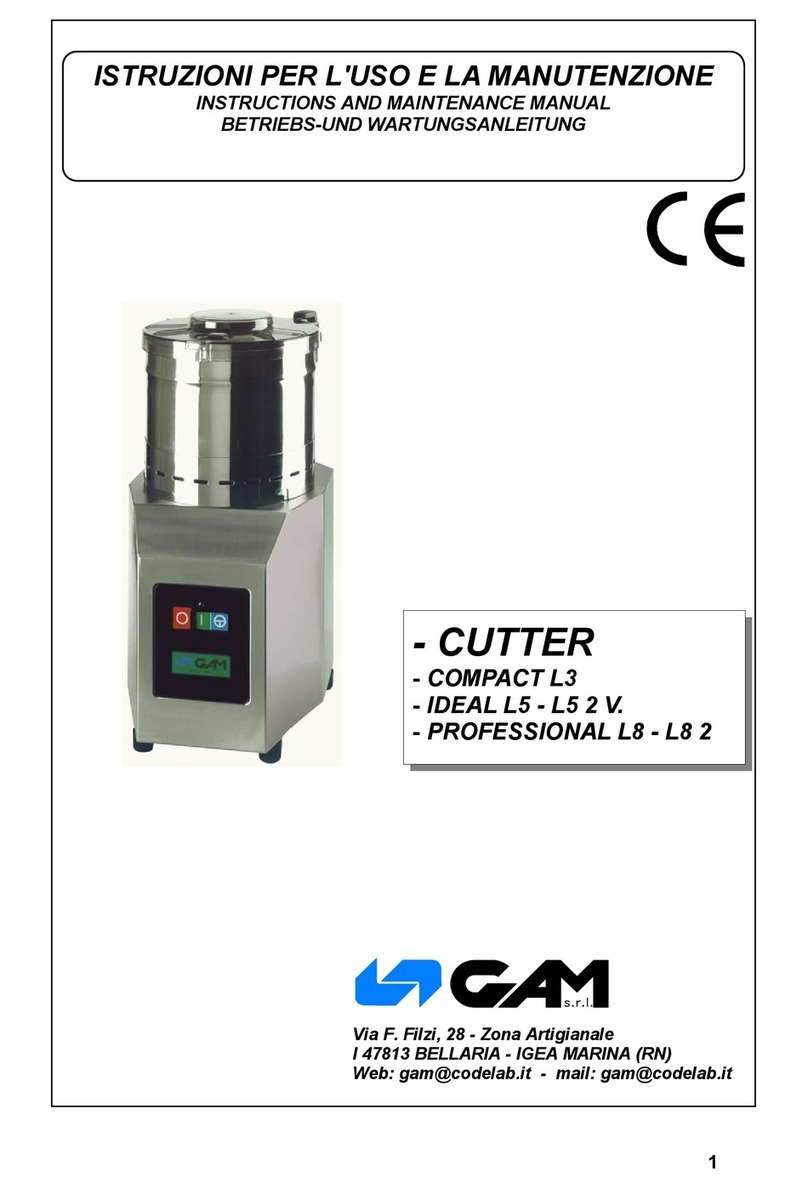
4/8
415010 en ma 2017-02
SECTION 1 GENERAL INFORMATION
IDENTIFICATION OF THE MACHINE
These instructions for use and maintenance relate to the following machine model:
"CUOCOJET" VEGETABLE-CUTTING MACHINE
A machine designed for cutting vegetables of all kinds, for use with foodstuffs only. On account of its design and features,
it can be installed in any workshop and used by commercial operations but it is not designed for industrial use.
MANUFACTURER:
The identification plate is attached at the rear of the machine on the left- hand side, close to the outlet of the power cable.
The data indicated in the identification plate are as follows:
TECHNICAL CHARACTERISTICS
Average production capacity about 200 kg/hr
Operation voltage 240-415V AC - 50 Hz
Installed power: single-phase 240V 50Hz 0.55kW (0.75HP) 3.5A
Installed power: three-phase 230 240V 50Hz 0.55kW (0.75HP) 1.8A
Installed power: three-phase 400 415V 50Hz 0.55kW (0.75HP) 1.0A
Net weight 20 kg
Average noise level 58 dB (A)
Overall dimensions (length/depth/height) 23,5 x 52,5 x 57,0 cm
Dimensions of packing (length/depth/height) 32,0 x 60,0 x 53,0 cm
Overall weight 22 kg
USES OF THE MACHINE
This machine is a high-performance cutter suitable for chopping all types of vegetables.
EQUIPMENT AND SPECIAL ACCESSORIES
The basic model of the machine includes the supply of the following devices and materials:
−1 high-ridge expulsion disk - no. 7 in exploded view
−1 low-ridge expulsion disk - no. 7 in exploded view
−1 vegetable presser (pestle) - no. 38 in exploded view
−1 copy of the spare parts catalogue with exploded view
−1 copy of the instructions and maintenance manual
−1 warranty certificate (to be validated by sales agent/retailer),
which must be returned within 8 days of purchase to the Builder
The safety measures and devices mentioned above conform to prescribed
standards in European regulations EEC 89/392 - 94/44 - 93/68.
ELECTRIC WIRING
The electric wiring of the machine is designed according to the technical regulations in CEI EN 60204-1 CEI 44- 6 section
1364, which refer to electrical parts and equipment in industrial machinery cf. Part 2 - Designation of the components and
examples of drawings, diagrams, tables etc.
A copy of this document is included as an appendix in this instructions manual.
WARNINGS AND INSTRUCTIONS REGARDING SAFETY
Please read the following warnings very carefully. Anyone who uses this machine must have read and be fully aware of
their content.
WARNINGS ALONE WILL NOT ELIMINATE THE RISK OF DANGER
Remember that instructions or warnings cannot replace industrial safety regulations and really act as a back-up measure,
reminding operators to respect the regulations, which must be observed at all times.
FAILURE TO OBSERVE ANY INSTRUCTIONS AND SAFETY REGULATIONS AND IMPROPER USE OF MACHINE
MAY LEAD TO INJURY OF THE OPERATOR.
NOISE LEVELS
Average values recorded at the main place of operation according to DIN 45635/a.
Noise level while switched on 53 dB(A)
Noise level during operation 65 dB(A)


























